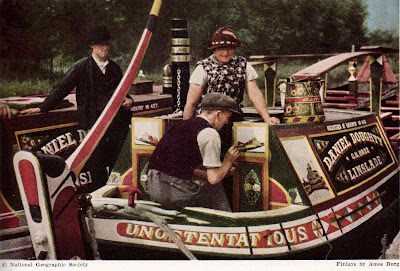The 1940 article describes a journey by canoe along the Grand Union to Birmingham and then onto Chester and Ellesmere Port via the Shropshire Union. It is fascinating on several levels. Firstly, there is the context of wartime Britain with the USA The canals at that time were undergoing a period of great change. The Grand Union Canal was then a recent development (its formation by merger was in 1929) and the line to Birmingham was being modernised with locks widened. As a result the pictures in the magazine are historically significant. Many are by the author. Amos Burg, who travelled with a companion using a Canadian canoe that he imported from his home in Oregon. Using a light canoe made for some interesting transits through tunnels; he and his companion were often towed by working boats. They also had to take measures to avoid getting too close to working boats and barges near locks.
Also, although I am not an expert, I think the colour plates in the article, and in the edition itself are interesting in their own right. Most are made using Kodachrome, which I suppose is not too surprising, but one is labelled as using the Dufay process. However, the colour plates taken by Amos Burg are labelled as being "Finlay(s)" because they used the RGB process invented by Mr Clare Finlay. It appears that the process was introduced around 1931.

An empty pair going north through Batchworth Lock on the Grand Union in the 1930s

Unostentatious being decorated at Rickmansworth